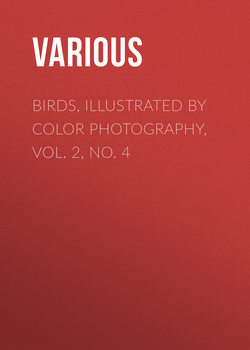Birds, Illustrated by Color Photography, Vol. 2, No. 4

Реклама. ООО «ЛитРес», ИНН: 7719571260.
Оглавление
Various. Birds, Illustrated by Color Photography, Vol. 2, No. 4
BIRDS IN CAPTIVITY
THE BLACKBURNIAN WARBLER
THE LOST MATE
THE AMERICAN GOLDFINCH
THE GOLDFINCH
THE CHIMNEY SWIFT
THE LARK
SHORE LARK
THE YELLOW-BELLIED SAPSUCKER
THE WARBLING VIREO
THE SAPSUCKER
THE WOOD PEWEE
THE WOOD PEWEE
THE WOOD PEWEE
THE SNOWFLAKE
THE SNOWFLAKE
THE SLATE-COLORED JUNCO
THE KINGBIRD
THE KINGBIRD
SUMMARY
Отрывок из книги
IF the children had had the naming of birds we venture to say that it would have been more appropriately done, and “Blackburnian,” as many other names of Warblers, would have had no place in literature. There are about seventy-five well known Warblers, nearly all with common names indicating the most characteristic colors or habits, or partly descriptive of the bird itself. The common names of this beautiful Warbler are Orange-throated Warbler and Hemlock Warbler. Some one has suggested that it should be called the Torch Bird, for “half a dozen of them as they flash about in the pines, raising their wings and jerking their tails, make the darkest shadows seem breaking into little tongues of flame.”
The Orange-throat is only migratory in Illinois, passing through in spring and fall, its summer home being chiefly if not wholly, to the northward, while it passes the winter in Central America and northern South America. It is found in New York and in portions of Massachusetts, frequenting the coniferous forests, and building its nest in bushes or small trees a few feet above the ground. Dr. C. Hart Merriam found a pair of these birds nesting in a grove of large white pines in Lewis County, New York. In the latter part of May the female was observed building, and on the second of June the nest contained four fresh eggs of the Warbler and one of the Cow bird. The nest was saddled on the horizontal limb about eight feet from the ground and about ten feet from the trunk. Nests have been found in pine trees in Southern Michigan at an elevation of forty feet. In all cases the nests are placed high in hemlocks or pines, which are the bird’s favorite resorts. From all accounts the nests of this species are elegantly and compactly made, consisting of a densely woven mass of spruce twigs, soft vegetable down, rootlets, and fine shreds of bark. The lining is often intermixed with horse hairs and feathers. Four eggs of greenish-white or very pale bluish-green, speckled or spotted, have usually been found in the nests.
.....
“Yes,” said his mamma, “the fluff carries the seed, like a sail to which the seed is fastened. By eating the seed, which otherwise would be carried by the wind all over the place, these birds do a great amount of good. The down they will use to line their nests.”
“How I should like to peep into their nest,” said Bobbie; “just to peep, you know; not to rob it of its eggs, as boys do who are not well brought up.”
.....